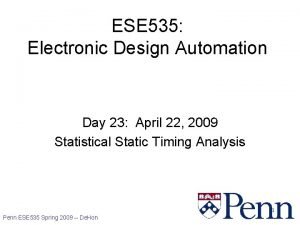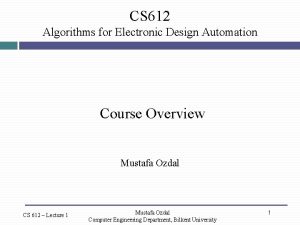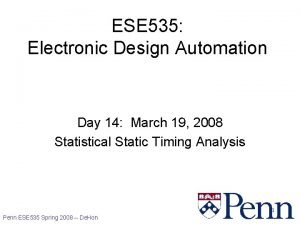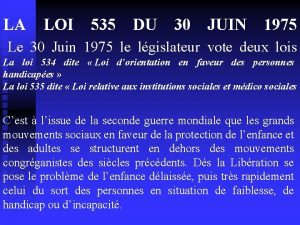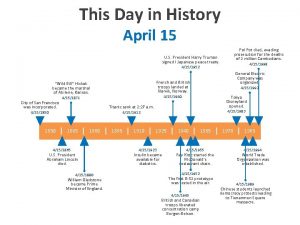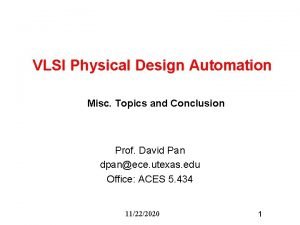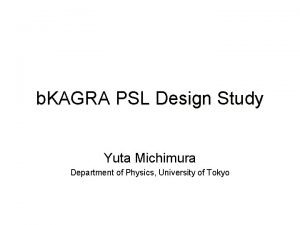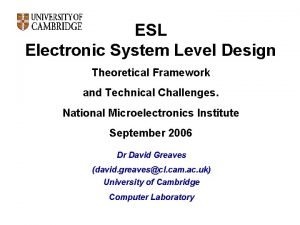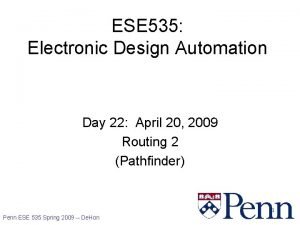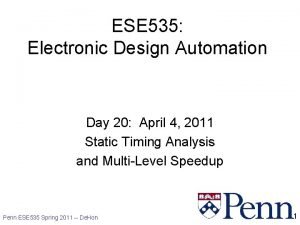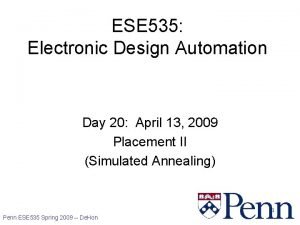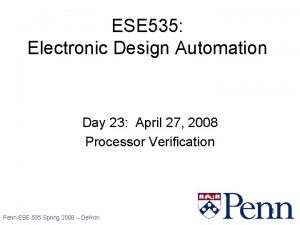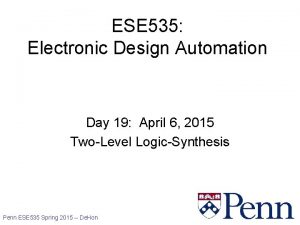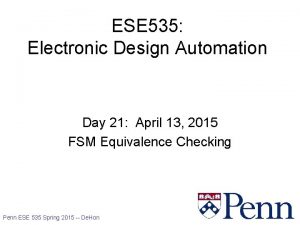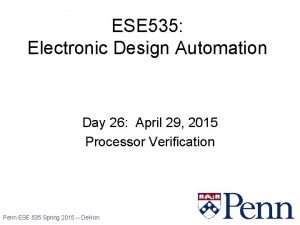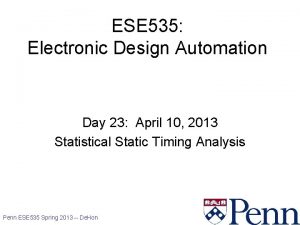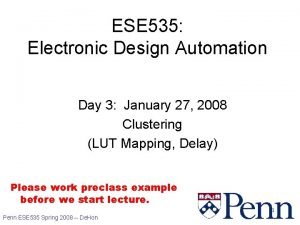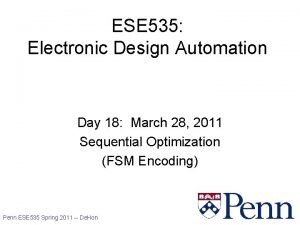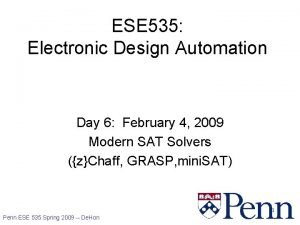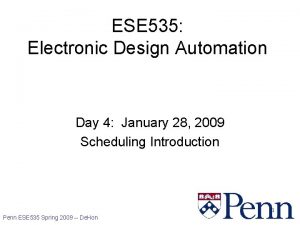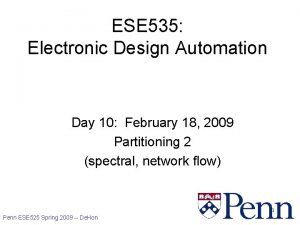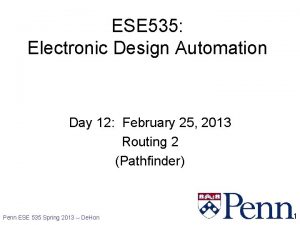ESE 535 Electronic Design Automation Day 21 April















































- Slides: 47

ESE 535: Electronic Design Automation Day 21: April 3, 2013 Multi-level Synthesis Penn ESE 353 Spring 2013 -- De. Hon 1

Behavioral (C, MATLAB, …) Today Arch. Select Schedule RTL • Multilevel Synthesis/Optimization – Why – Transforms -- defined – Division/extraction • How we support transforms FSM assign Two-level Multilevel opt. Covering Retiming Gate Netlist Placement Routing Layout Masks Penn ESE 353 Spring 2013 -- De. Hon 2

Multi-level Logic • General circuit netlist • May have – sums within products – products within sum – arbitrarily deep • y=((a (b+c)+e)fg+h)i Penn ESE 353 Spring 2013 -- De. Hon 3

Why Multi-level Logic? • ab(c+d+e)(f+g) • abcf+abdf+abef+abcg+abdg+abeg • 6 product terms 23 2 -input gates • vs. 3 gates: and 4, or 3, or 2 6 2 -input gates • Aside from Pterm sharing between outputs, – two level cannot share sub-expressions Penn ESE 353 Spring 2013 -- De. Hon 4

Why Multi-level Logic • a xor b – a/b+/ab • a xor b xor c – a/bc+/a/b/c+ab/c • a xor b xor c xor d – a/bcd+/a/b/cd+ab/cd+/ab/c/d+a/b/c/d+abc/d+/a/bc/d Penn ESE 353 Spring 2013 -- De. Hon 5

Why Multilevel • a xor b – a/b+/ab • a xor b xor c – a/bc+/a/b/c+ab/c • a xor b xor c xor d – a/bcd+/a/b/cd+ab/cd +/ab/c/d+a/b/c/d+abc/d+/a/ bc/d Penn ESE 353 Spring 2013 -- De. Hon Compare • a xor b – x 1=a/b+/ab • a xor b xor c – x 2=x 1/c+/x 1*c • a xor b xor c xor d – x 3=x 2/d+x 2*d 6

Why Multilevel • a xor b – x 1=a/b+/ab • a xor b xor c – x 2=x 1/c+/x 1*c • a xor b xor c xor d – x 3=x 2/d+x 2*d Penn ESE 353 Spring 2013 -- De. Hon • Multi-level – exploit common sub-expressions – linear complexity • Two-level – exponential complexity 7

Goal • Find the structure • Exploit to minimize gates – Total (area) – In path (delay) Penn ESE 353 Spring 2013 -- De. Hon 8

Multi-level Transformations • • • Decomposition Extraction Factoring Substitution Collapsing [copy these to board so stay up as we move forward] Penn ESE 353 Spring 2013 -- De. Hon 9

Decomposition • F=abc+abd+/a/c/d+/b/c/d • F=XY+/X/Y • X=ab • Y=c+d Penn ESE 353 Spring 2013 -- De. Hon 10

Decomposition • F=abc+abd+/a/c/d+/b/c/d – 4 3 -input + 1 4 -input 11 2 -input gates • F=XY+/X/Y • X=ab • Y=c+d – 5 2 -input gates • Note: use X and /X, use at multiple places Penn ESE 353 Spring 2013 -- De. Hon 11

Extraction • F=(a+b)cd+e • G=(a+b)/e • H=cde Penn ESE 353 Spring 2013 -- De. Hon • • • F=XY+e G=X/e H=Ye X=a+b Y=cd 12

Extraction • F=(a+b)cd+e • G=(a+b)/e • H=cde • 2 -input: 4 • 3 -input: 2 8 2 -input gates • • • F=XY+e G=X/e H=Ye X=a+b Y=cd • 2 -input: 6 Common sub-expressions over multiple output Penn ESE 353 Spring 2013 -- De. Hon 13

Factoring • F=ac+ad+bc+bd+e • F=(a+b)(c+d)+e Penn ESE 353 Spring 2013 -- De. Hon 14

Factoring • F=ac+ad+bc+bd+e – 4 2 -input, 1 5 -input 8 2 -input gates – 9 literals • F=(a+b)(c+d)+e – 4 2 -input – 5 literals Penn ESE 353 Spring 2013 -- De. Hon 15

Substitution • G=a+b • F=a+bc • Substitute G into F • F=G(a+c) – (verify) F=(a+b)(a+c)=aa+ab+ac+bc=a+bc • useful if also have H=a+c, then F=GH Penn ESE 353 Spring 2013 -- De. Hon 16

Collapsing • F=Ga+/Gb • G=c+d • F=ac+ad+b/c/d • opposite of substitution – sometimes want to collapse and refactor – especially for delay optimization [saw last time] Penn ESE 353 Spring 2013 -- De. Hon 17

Moves • These transforms define the “moves” we can make to modify our network. • Goal is to apply, usually repeatedly, to minimize gates – …then apply as necessary to accelerate design • MIS/SIS – Applies to canonical 2 -input gates – Then covers with target gate library • Day 2 Penn ESE 353 Spring 2013 -- De. Hon 18

Division Penn ESE 353 Spring 2013 -- De. Hon 19

Division • Given: function (f) and divisor (p) • Find: quotient and remainder f=pq+r E. g. f=abc+abd+ef, p=ab q=c+d, r=ef Penn ESE 353 Spring 2013 -- De. Hon 20

Algebraic Division • Use basic rules of algebra, rather than full boolean properties • Computationally simple • Weaker than boolean division • f=a+bc p=(a+b) • Algebra: not divisible • Boolean: q=(a+c), r=0 Penn ESE 353 Spring 2013 -- De. Hon 21

Algebraic Division Given: function (f) and divisor (p) Find: quotient and remainder f=pq+r • f and p are expressions (lists of cubes) – p={a 1, a 2, …} • Define: hi ={cj | ai * cj f} • f/p = h 1 h 2 h 3… Penn ESE 353 Spring 2013 -- De. Hon 22

Algebraic Division Example (adv to alg. ; work ex on board) • f=abc+abd+de • p=ab+e Penn ESE 353 Spring 2013 -- De. Hon 23

Algebraic Division • • f and p are expressions (lists of cubes) p={a 1, a 2, …} hi ={cj | ai * cj f} f/p = h 1 h 2 h 3… Penn ESE 353 Spring 2013 -- De. Hon 24

Algebraic Division Example • f=abc+abd+de, p=ab+e • • • p={ab, e} h 1={c, d} h 2={d} h 1 h 2={d} f/p=d Penn ESE 353 Spring 2013 -- De. Hon • r=f- p *(f/p) • r=abc+abd+de-(ab+e)d • r=abc 25

Algebraic Division Time • O(|f||p|) as described – compare every cube pair • Sort cubes first – O((|f|+|p|)log(|f|+|p|) Penn ESE 353 Spring 2013 -- De. Hon 26

Primary Divisor • f/c such that c is a cube • f =abc+abde • f/a=bc+bde is a primary divisor Penn ESE 353 Spring 2013 -- De. Hon 27

Cube Free • The only cube that divides p is 1 • c+de is cube free • bc+bde is not cube free Penn ESE 353 Spring 2013 -- De. Hon 28

Kernel • Kernels of f are – cube free primary divisors of f – Informally: sums w/ cubes factored out • f=abc+abde • f/ab = c+de is a kernel • ab is cokernel of f to (c+de) – cokernels always cubes Penn ESE 353 Spring 2013 -- De. Hon 29

Factoring • Gfactor(f) if (terms==1) return(f) p=CHOOSE_DIVISOR(f) (h, r)=DIVIDE(f, p) f=Gfactor(h)*Gfactor(p)+Gfactor(r) return(f) // factored Penn ESE 353 Spring 2013 -- De. Hon 30

Factoring • Trick is picking divisor – pick from kernels – goal minimize literals after resubstitution • Re-express design using new intermediate variables • Variable and complement Penn ESE 353 Spring 2013 -- De. Hon 31

Kernel Extraction • Kernel 1(j, g) • Find cf = largest cube factor of f • K=Kernel 1(0, f/cf) • if (f is cube-free) – return(f K) • else – return(K) Must be to Generate Non-trivial kernel – R=g – N max index in g – for(i=j+1 to N) • if (li in 2 or more cubes) – cf=largest cube divide g/li – if (forall k i, lk cf) » R=R KERNEL 1(i, g/(li cf)) – return(R) Consider each literal for cokernel once (largest cokernels will already have been found) Penn ESE 353 Spring 2013 -- De. Hon 32

Kernel Extract Example (ex. on board; adv to return to alg. ) • f=abcd+abce+abef Penn ESE 353 Spring 2013 -- De. Hon 33

Kernel Extraction • Kernel 1(j, g) Must be to Generate Non-trivial kernel – R=g – N max index in g – for(i=j+1 to N) • if (li in 2 or more cubes) – cf=largest cube divide g/li – return(f K) – if (forall k i, lk cf) • else » R=R – return(K) KERNEL 1(i, g/(li cf)) – return(R) Consider each literal for cokernel once (largest cokernels will already have been found) • Find cf = largest cube factor of f • K=Kernel 1(0, f/cf) • if (f is cube-free) Penn ESE 353 Spring 2013 -- De. Hon 34

Kernel Extract Example (stay on prev. slide, ex. on board) • • f=abcd+abce+abef cf=ab f/cf=cd+ce+ef R={cd+ce+ef} N=6 a, b not present (cd+ce+ef)/c=e+d largest cube 1 Penn ESE 353 Spring 2013 -- De. Hon • • • Recurse e+d R={cd+ce+ef, e+d} only 1 d (d+ce+ef)/e=c+f Recurse c+f R={cd+ce+ef, e+d, c+f} 35

Extraction Identify cube-free expressions in many functions (common sub expressions) 1. Generate kernels for each function 2. select pair such that k 1 k 2 is not a cube • • Note: k 1=k 2 is simplest case of this …but intersection case is more powerful • 3. new variable from intersection – 4. Example to come v= k 1 k 2 update functions (resubstitute) – fi = v*(fi /v)+ ri 1. (similar for common cubes) Penn ESE 353 Spring 2013 -- De. Hon 36

Extraction Example • X=ab(c(d+e)+f+g)+g • Y=ai(c(d+e)+f+j)+k Penn ESE 353 Spring 2013 -- De. Hon 37

Extraction Example • • • X=ab(c(d+e)+f+g)+g Y=ai(c(d+e)+f+j)+k d+e kernel of both L=d+e X=ab(c. L+f+g)+h Y=ai(c. L+f+j)+k Penn ESE 353 Spring 2013 -- De. Hon 38

Extraction Example • • L=d+e X=ab(c. L+f+g)+h Y=ai(c. L+f+j)+k kernels: (c. L+f+g), (c. L+f+j) extract: M=c. L+f X=ab(M+g)+h Y=ai(M+f)+h Penn ESE 353 Spring 2013 -- De. Hon 39

Extraction Example • • • L=d+e M=c. L+f X=ab(M+g)+h Y=ai(M+j)+h no kernels common cube: a. M Penn ESE 353 Spring 2013 -- De. Hon • • • N=a. M M=c. L+f L=d+e X=b(N+ag)+h Y=i(N+aj)+k 40

Extraction Example • • • N=a. M M=c. L+f L=d+e X=b(N+ag)+h Y=I(N+aj)+k Penn ESE 353 Spring 2013 -- De. Hon • Can collapse – L into M into N – Only used once • Get larger common kernel N – maybe useful if components becoming too small for efficient gate implementation 41

Resubstitution • • Also useful to try complement on new factors f=ab+ac+/b/cd X=b+c f=a. X+/b/cd /X=/b/c f=a. X+/Xd …extracting complements not a direct target Penn ESE 353 Spring 2013 -- De. Hon 42

Multilevel Optimization • • Unlike Two-level, very heuristic Not clear when done Goal find common terms to share Often start with two-level optimization – Identifies product term sharing • • • Identify kernels and cubes Factor them out If can be used many places, get benefit Sis included common recipes More after timing analysis Penn ESE 353 Spring 2013 -- De. Hon 43

Summary • Want to exploit structure in problems to reduce (contain) size – common sub-expressions • Identify component elements – decomposition, factoring, extraction • Division key to these operations • Kernels give us divisors Penn ESE 353 Spring 2013 -- De. Hon 44

Big Ideas • Exploit freedom – form • Exploit structure/sharing – common sub expressions • Techniques – Iterative Improvement – Refinement/relaxation Penn ESE 353 Spring 2013 -- De. Hon 45

Announcement Friday April 5, 3: 30 pm: Interesting talk on “Nano-scale VLSI Technologies: Silicon & Beyond” Dr. Kevin Zhang, Intel Fellow Room 337 Town Building 46

Admin • Everyone should have received Assignment 6 feedback in email • Reading for Monday on blackboard • Milestone Mondays… Penn ESE 353 Spring 2013 -- De. Hon 47
 535 days before 23 april
535 days before 23 april Day 1 day 2 day 3 day 4
Day 1 day 2 day 3 day 4 Cs 612
Cs 612 Day 1 day 2 day 817
Day 1 day 2 day 817 535 before 7 february
535 before 7 february 535 before 14 march
535 before 14 march Securiton adw 535 bedienungsanleitung
Securiton adw 535 bedienungsanleitung Loi 75-535 du 30 juin 1975
Loi 75-535 du 30 juin 1975 Rust airfield radiation
Rust airfield radiation Ssd 535-2
Ssd 535-2 Lag nord
Lag nord Mgt 535
Mgt 535 Astronomy picture of the day 17 april 2001
Astronomy picture of the day 17 april 2001 I'm building a rocket poem
I'm building a rocket poem 20. april 1889
20. april 1889 This day in history april 15
This day in history april 15 National sovereignty and childrens day
National sovereignty and childrens day History of april fools day in islam
History of april fools day in islam International day april 4
International day april 4 April 28 day of mourning
April 28 day of mourning Is the electronic exchange of money or scrip
Is the electronic exchange of money or scrip Electronic news gathering and electronic field production
Electronic news gathering and electronic field production Design automation for embedded systems
Design automation for embedded systems Optima design automation
Optima design automation Physical design
Physical design Jasper design automation
Jasper design automation Electronic engineering
Electronic engineering Property specification language
Property specification language William beanes elementary
William beanes elementary Oceans apart day after day
Oceans apart day after day Day to day maintenance
Day to day maintenance Physical science chapter 6 review answers
Physical science chapter 6 review answers Tomorrow i dont know
Tomorrow i dont know Romeo and juliet day timeline
Romeo and juliet day timeline Growing day by day
Growing day by day Observation of seed germination day by day
Observation of seed germination day by day Day by day seed germination observation chart
Day by day seed germination observation chart Role of transpiration
Role of transpiration I live for jesus day after day
I live for jesus day after day Casting crowns dying he saved me
Casting crowns dying he saved me Day one day one noodle ss2
Day one day one noodle ss2 Afc futsal coaching course level 1
Afc futsal coaching course level 1 System-level design
System-level design Electronic system level design
Electronic system level design Ese argumentuese
Ese argumentuese Sjellja konsumatore
Sjellja konsumatore Jeta private ese
Jeta private ese Librat e shekspirit
Librat e shekspirit
